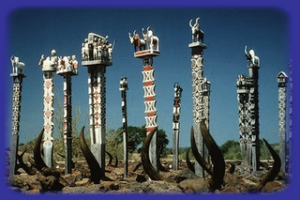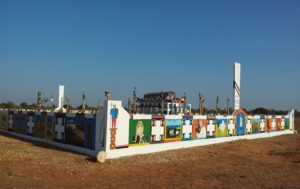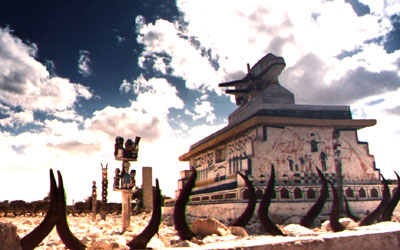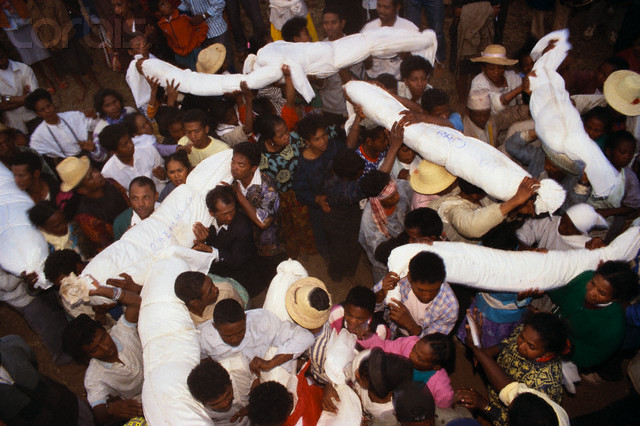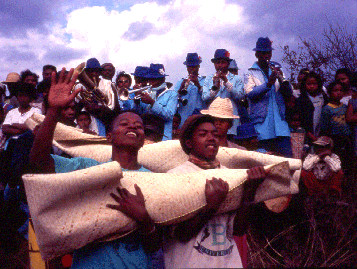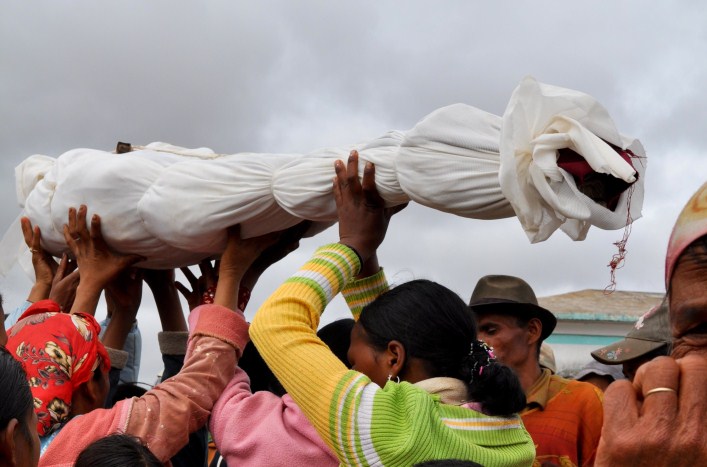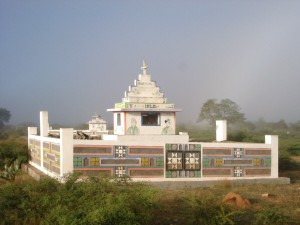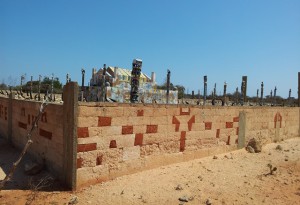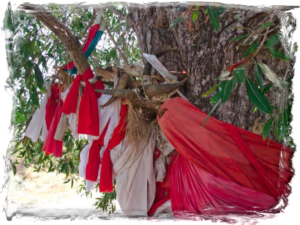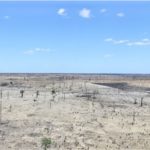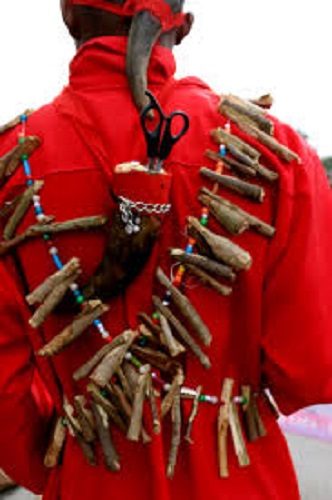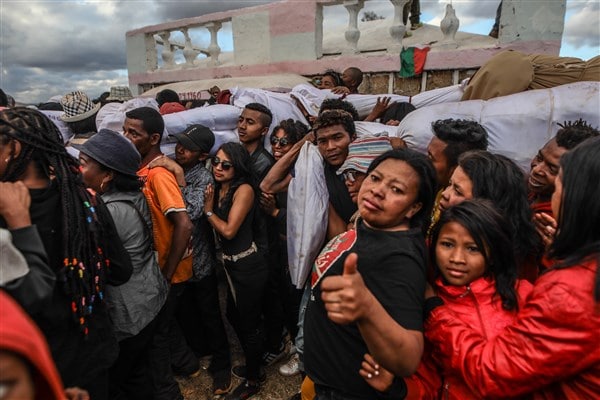Graves
In particular the Ancestral world has a prominent meaning in the life of most inhabitants on Madagascar, which extends to all areas of life. In the imaginary world of the Malagasy, there is no hell and no paradise, but also no rebirth; rather, they believe that after death they will live in the realm of their ancestors (Razana) to be united with them and from there to watch over the living.
Due to this constant presence in everyday life, the contact with the ancestors is therefore an indispensable part of life, which is expressed in various sacrificial rites, oracles and especially in the burial culture on Madagascar.
Graves and tombs are not only places of worship or special rites in Madagascar (like the Famadihana) - as Resting place of the ancestors they have a much higher value than the houses of the living. Thus, stone houses became popular in Madagascar only in the 19th century; before that, stones had been used only for burial structures; for the living, wood was "good enough"!
The graves are usually found outside the settlements in very scattered places but they can also be the center of the villages, be located in the rice fields, be under huge slabs of rock in the mountains, be in crevices & caves. Often they are decorated with zebra skulls, which is supposed to indicate the wealth of the deceased. At the Highlanders In some places, however, it is also customary to place zebra skulls at the graves as a warning and as a seal of inviolability.
Famadihana-the reunion with the ancestors
Burial of the dead or Turn of the corpse, the FamadihanaThis is certainly the custom in Madagascar that seems most alien to us Europeans, since in this country we consider the repose of the dead and the sanctity of the graves to be something sacred.
In Madagascar, the world of the ancestors is closely connected with the world of the living. The Reunion with the deceased members of the family is an absolute highlight, which is also to strengthen the cohesion of the living.
In Madagascar, the immense importance of the "Razana", the ancestors, is firmly anchored in the everyday life of the people and the community. However, if you consider the immense importance of the ancestors for the daily life of the inhabitants in Madagascar, it becomes clear very quickly that here the community of the Madagascans with their ancestors experiences the highest and strongest manifestation, and the people therefore have a need to become aware of their ancestors at times.
That this is also a reciprocal aspect is shown by the fact that at the Famadihana the ancestors are introduced to those who came into the world since the last reburial. The ancestors are "supplied" with stories and information, and the ubiquitous rum offering flows thereby not only into the earth, but abundantly into many throats.
The Famadihana is not only practiced in the highlands of Madagascar, there are very different variants in almost every Tribes of Madagascarand it would take far too long to describe them all even briefly.
There are also regional variations such as the Washing of the royal bones (fitampona) with the Sakalava. In addition to opening the graves, which, given the location of some graves, at the Bara in caves in the middle of a steep rocky slope, for example, is often a life-threatening undertaking, clothing the bones with new precious burial cloths, the Lamba mena (red cloth) represents the very core of the celebration.
The Famadihana is held at intervals of 3,5,7 to 9 years, often irregularly: if you imagine the immense effort that a family has to make to provide the whole village with plenty of food and drink, the economic problems of this tradition become clear!
The cost of the celebrations often drives the family into years of debt bondage, inhibiting any economic advancement. This is all the more so because it is constantly repeated - some Madagascar experts have claimed that it is this tradition that hinders Madagascar's development the most.... However, it must be said that, like all traditions, this one too is visibly losing its importance, the enormous differences between urban and rural populations indicating a departure from the old customs, especially on the part of the urbanites. Often it is also the sheer "common sense" and the adoption of a modern and more pragmatic worldview by more and more Malagasy that is evident here.
The procedure of a burial of the dead among the Merina on Madagascar
The occasion of the feast may begin through a dream of a family member, for example, if a family member in a dream received a visit from a deceased relative. The latter may have complained that he was cold and hungry, that he felt forgotten, or that his cloths were dirty. A Family Council is immediately convened and the members decide whether the moment is favorable for the reburial, then still decide the local Astrologers how and when exactly the celebration should take place and what procedure it should have.
After that, all other family members are notified, and they do everything possible to participate in the celebration, even those who live abroad, in no case miss the Meeting with their deceased ancestors.
A lot of money has to be saved, and often poorer families fall into poverty and debt in the long run, the effort is nevertheless worthwhile for the families concerned, through the increased reputation of the village community, and of course through the thanks of the ancestors.
Usually people know exactly when the next reburial of the dead will take place, because it was already decided at the last celebration when the shrouds were tied together. If the dead person was bound three times, the next celebration is in three years, it can be every three years or every five, seven or nine years.
On the eve of the celebration, the oldest members of the family go to the grave and explain to the dead who will come out of the grave the next day by decision of the family, and who of the living will participate in the celebration of the dead. As everywhere in Madagascar, a celebration is unthinkable without good speeches; good speakers are very highly regarded.
The next morning the two heavy stone doors of the family tomb are opened, a flag floats on the roof of the tomb, and the oldest and most respected personalities stand on it and make speeches. The mayor calls out the names of the deceased, who are carried out of the tomb, men of the family go one by one and bring the bundled and wrapped dead to the light.
Family members, invited and uninvited guests, curious passers-by, children, and even foreigners like to participate, for the family it is an honor when many people participate in the feast, and especially when Europeans are involved, it greatly increases the prestige of the family, and therefore they are always welcome.
Those present donate a small amount of money in an envelope to the family, everything is written down in detail, and the donors receive an equivalent donation when their dead are reburied.
While the dead wait wrapped in their shawls in the shade, the guests proceed to lunch. Vast amounts of rice and other ingredients are eaten, the flutes, drums, clarinets and trumpets of the musicians play joyful rhythms, it is a very happy feast, and mourning is very badly regarded. The music is so loud that it could awaken the dead, and that is probably what is intended. People flock from all over to sing, drink and dance, the dead are touched, they are told everything that has happened in the village since their death or since the last reburial. Depending on the tribe, the process and the rites can be totally different, I will now describe only one reburial, as it is tradition in the highlands.
The ancestors lie on straw mats amidst the dancing crowd of overjoyed Madagascans, elderly men whose parents are still alive take care of the bodies of the ancestors with infinite devotion and respect, the cloths are labeled so that you know who they contain. In some cloths there are two bodies, the spouses who have met again after death, and remain united forever.
In the highlands, new cloths are put over the old ones, and narrow strips are then cut from these cloths with a razor blade, which are used to tie them down, and whose number symbolizes the years until the next reburial. In the past these cloths were made of red wild silk (Lamba Mena), nowadays they are often cheap synthetic cloths. At the end of the afternoon, the dead are often carried through the village, the people sing and dance with them, lifting them above their heads with outstretched hands and giving them to other members of the family who continue the dance.
People are totally happy with each other.
After the dead have danced around the tomb seven times with the living, they come back to their resting place, and this must have happened before sunset. Inside the tomb there is a kind of shelf on three steps, of course they have a certain place according to their rank and importance in the ancestral world. Parents and grandparents are in the northern part, sons are in the east, unmarried daughters are in the south, and the west is always left as the direction for the entrance.
Very many taboos are connected with the graves and the ancestors: the entrance of a tomb should never be opposite a dwelling, otherwise the living will be drawn into death, one should never point to a grave with an outstretched finger, one should never walk on a straight path from the village to the grave, otherwise death can easily follow you, polygamy (illegitimate women or 2nd marriage) in the grave is strictly taboo. Male children who are not circumcised are not allowed in the grave, and the same goes for girls who do not have holes for earrings in their ears.
The wrapped dead are carried into the grave in straw mats, and these are carried out again after the dead have been arranged, the young women very much want to use these mats, where the dead have lain on them, as a base to sleep on.
According to them, this brings fertility and many children. Very much faith and superstition is closely connected with the world of the ancestors, when the grave doors are closed and the seals are closed with cement, the mason is allowed to paint the cement only upwards towards the sky, this symbolizes the world of the living, downwards towards the earth the world of the dead.
The hands and face must be washed thoroughly after a famadiahana.
It is unbearable when the bodies of the deceased cannot come into contact with the ancestors, this often happened during the two world wars where the Malagasy served with other Africans as "cannon fodder" for the French colonial power. In that case, stone statues of the deceased (often in recognizable uniforms with caps) are dedicated next to the tombs, and the deceased are then viewed as if the body were present in the tomb.
The dead are transported in coffins (usually simple boxes made of unpolished boards). When you pass a shared cab with a native flag flying on the roof, everyone knows that a corpse is being transported on the roof, amidst other luggage of the other passengers. The coffins never make it to the graves, they rot somewhere next to them and sometimes on the roofs of the tombs.
The procedure is very different from one tribe to another and from one region to another. The repatriation of the dead takes place between June and the beginning of September, that is, in the southern winter.
Fady
Every traveler to Madagascar should be clear about the meaning of certain taboos, the fady, before starting the journey. Strangely enough, the term itself is hardly ever used or pronounced by a Madagascan. One speaks then simply of taboo. Fady are religious prohibitions, which concern certain places or ways of acting. For example, it is very often forbidden in sacred places in Madagascar to bring or eat pork or salt (e.g. on the Rova in Antananarivo) or to walk with shoes on. Women, especially during their menstrual periods, are also prohibited from entering many places in Madagascar. Fady, for example, is:
To go from a grave to the village on a straight path: otherwise death finds its way into the village all too easily. Often zebra skulls mark places of the fady - but some things are not so easy to recognize. Whoever breaks a fady on Madagascar has incurred a heavy debt, which he - if at all! - can only be washed away by a zebu sacrifice! As a rule, however, the traveler on Madagascar will be pointed out to the applicable prohibitions before entering an interesting place, and one does not have to fear to commit a sacrilege.
If it is possible for you, get into the habit on Madagascar not to point at anything or anyone with your finger - and instead point with your whole hand or fist in the meant direction: Especially a finger pointing in the direction of a grave is considered fady, in Bemaraha NP you are not allowed to point at anything with your finger and under no circumstances take anything from the area! Even if you think this is hocus-pocus -. observe the commandments and traditions of the people of Madagascar !

